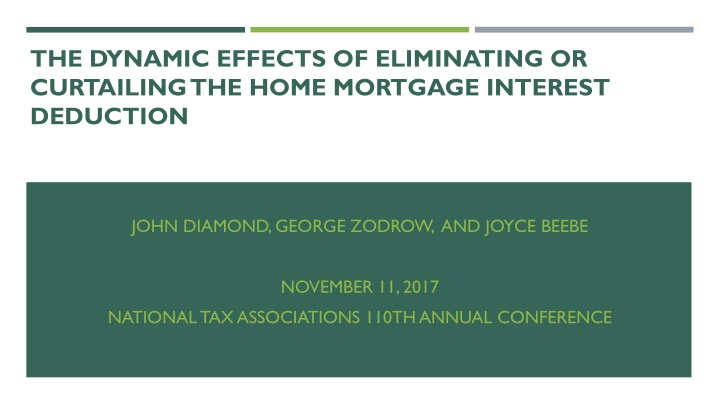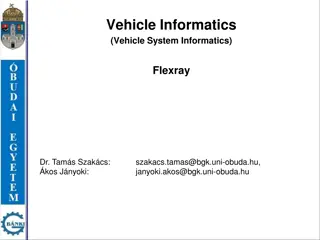
Effects of Eliminating Home Mortgage Interest Deduction in Tax Cuts and Jobs Act
Explore the dynamic impact of curtailing the home mortgage interest deduction outlined in the Tax Cuts and Jobs Act. Discover reactions from NAR and NAHB, as well as insights on the MID and recent reform proposals.
Download Presentation

Please find below an Image/Link to download the presentation.
The content on the website is provided AS IS for your information and personal use only. It may not be sold, licensed, or shared on other websites without obtaining consent from the author. If you encounter any issues during the download, it is possible that the publisher has removed the file from their server.
You are allowed to download the files provided on this website for personal or commercial use, subject to the condition that they are used lawfully. All files are the property of their respective owners.
The content on the website is provided AS IS for your information and personal use only. It may not be sold, licensed, or shared on other websites without obtaining consent from the author.
E N D
Presentation Transcript
THE DYNAMIC EFFECTS OF ELIMINATING OR CURTAILING THE HOME MORTGAGE INTEREST DEDUCTION JOHN DIAMOND, GEORGE ZODROW, AND JOYCE BEEBE NOVEMBER 11, 2017 NATIONAL TAX ASSOCIATIONS 110TH ANNUAL CONFERENCE
TAX CUTS AND JOBS ACT (H.R.1) Provisions relevant to homeownership and housing: Preserve the home mortgage interest deduction: up to $500,000, primary residence only (from current $1 million dollars, primary residence and second home) Allow deduction of state and local property taxes up to $10,000 Gain from sale of a principal residence: exclude up to $500,000 from taxable income, 5 out of 8 years, phasing out dollar-for-dollar for AGI exceeding $500,000 (from current 2 out of 5 years, no AGI limit) 2
NAR REACTION TO HOUSING RELATED PROVISIONS IN TAX CUTS AND JOBS ACT Eliminating tax incentives for homeownership puts home values and middle-class homeowner at risk. Homeowners could lose substantial equity from the more than 10% drop in home values likely to result if the bill is enacted. 3
NAHB REACTION TO HOUSING RELATED PROVISIONS IN TAX CUTS AND JOBS ACT 4
AGENDA Introduction Background Information of Mortgage Interest Deduction (MID) Overview of the Model and Initial Equilibrium Simulation Results Conclusion 5
INTRODUCTION Home Mortgage Interest Deduction (MID) is one of the largest individual income tax expenditures Increasing debt and deficit both tax reform and spending cuts are necessary MID is popular, hence politically sensitive Primary rationale is to promote home ownership, but Current MID not well designed to achieve this goal Provides no subsidy to low and middle income individuals if they don t itemize For high income taxpayers, encourages overconsumption 7
INTRODUCTION: RECENT REFORM PROPOSALS National Commission on Fiscal Responsibility and Reform (2010, the Simpson- Bowles report)* would: Replace MID with a 12% nonrefundable tax credit for interest paid Cap at mortgage amount of $500,000 Apply to principal residence only (no second or vacation homes) Not preclude eliminating MID if consider more sweeping reforms Tax Reform Act of 2014 (2014, the Camp bill): Cap at mortgage amount of $500,000 8 *Bipartisan Policy Center, Debt Reduction Task Force (2010) recommends that the MID be replaced with a 15 percent refundable tax credit for up to $25,000 of home mortgage interest expense on a principal residence, and also recommends eliminating the MID for second or vacation homes.
INTRODUCTION: RECENT REFORM PROPOSALS (CONT D) House Republican Tax Reform Plan (June 2016, HRTP): Preserve the MID Making the MID a more effective and efficient incentive for home ownership unspecified changes Trump Administration Tax Proposal (November 2017) Preserve the MID Cap interest deductions to a $500,000 mortgage Important to understand the dynamic effects of revising the current MID under the current income tax Will draw policies analyzed from reform proposals 9
II. BACKGROUND INFORMATION OF MORTGAGE INTEREST DEDUCTION 10
BACKGROUND INFORMATION OF MORTGAGE INTEREST DEDUCTION (MID) In 2016, tax expenditure for MID was about $59 billion (JCT, 2017) to 63 billion (OMB, 2016). MID first increases then declines with age: But MID increases less than proportionately with AGI Table II.1 Home Mortgage Interest Deductions by Age (2014, $billion) Age AGI All returns 6,385 Under 18 2 18 to under 26 34 26 to under 35 490 35 to under 45 1,249 45 to under 55 1,762 55 to under 65 1,606 65 and over 1,242 Source: IRS Statistics of Income, 2016, Table 2.6 MID 287 0 1 26 71 87 65 36 MID/AGI (%) 4.5 0.9 3.1 5.4 5.7 5.0 4.0 2.9 11
BACKGROUND (CONTD) Poterba and Sinai (2011) use 2004 Survey of Consumer Finances (SCF), supplemented by TAXSIM (Feenberg and Coutts, 1993), classify households using a more comprehensive measure of income than AGI: Measure of Income = AGI + income from non-taxable investments + employer contributions to social security + unemployment insurance and workers compensation + gross Social Security income + some additional preference items under the alternative minimum tax Using this measure of income, we updated Poterba and Sinai s results using 2016 SCF data. Home value increases with income & age group LTV ratios decline at high income; flat or increase at lower income 12
BACKGROUND (CONTD) MID is more valuable to higher income taxpayers as they face higher marginal tax rates Distributional effects of eliminating MID* - concentrated in the upper income classes 13 *Static effects of eliminating MID, neglecting behavioral effects.
OVERVIEW OF THE MODEL AND INITIAL EQUILIBRIUM Dynamic, overlapping generations, computable general equilibrium (CGE) model of the U.S. economy that focuses on the macroeconomic, distributional, and transitional effects of tax reforms Consumers: labor supply, consumption, and saving to maximize their welfare over a 55-year adult life 55 generations alive at any given point in time, and each generation includes 12 lifetime income groups, each characterized by its own lifetime earnings profile, government transfers profile, wealth holdings, consumption and saving patterns Maximize lifetime utility (discounted sum of annual utilities) subject to lifetime budget constraint Nested CES function with four consumer goods: a non-housing composite consumption good produced by the corporate sector (C), a non-housing composite consumption good produced by the non-corporate sector (N), owner-occupied housing (H), and rental housing (R) 15
OVERVIEW OF THE MODEL (CONTD) Business firms: Firm managers maximize profits/value of firms Calculate the optimal time path of investment for changes in the tax structure, considering adjustment costs One firm for each production sector; Cobb-Douglas production function Corporate sector (C), subject to CIT; non-corporate (N) and rental housing (R) sectors, taxed on a pass-through basis Owner-occupied housing (H) sector: an untaxed private firm combines capital and labor to produce housing and then rents housing services to homeowners MID benefits are incorporated into the model as reductions in the prices of housing services, which differ across income groups 16
OVERVIEW OF THE MODEL (CONTD) Government: finances an exogenously specified time path of public services and government transfers Tax instruments: CIT and a personal income tax with a progressive wage income tax structure (modeled as different constant marginal tax rates applied to the labor income of each of the 12 income groups), and a single constant rate capital income tax rate. After the enactment of reform, the model will arrive at a steady state equilibrium where all key macroeconomic variables (GDP, outputs in various sectors, capital stock, effective labor force) grow at the steady state rate an exogenously defined constant rate equals to the sum of population growth rate and the rate of technological growth Reform induced changes in asset values in each market, for each period after the reform can be calculated can consider changes in tax treatment of existing capital assets, as well as their previous tax treatment under the existing tax system transitional effects on prices of housing and other assets and redistributions across all generations 17
INITIAL EQUILIBRIUM Initial equilibrium: a stylized representation of the U.S. economy in 2016 The last decade has been characterized by a boom, a bust, and then a recovery in the housing sector The excess supply of housing in 2009 has dissipated and possibly reversed: Vacancy rates of housing averaged 1.6 percent in 1980 and 1990s*. Vacancy rates averaged 2.7 percent in 2007-2009, have been declining since 2010 and were 1.8 percent in 2016. Over the last five years to 2017, total housing inventory has been below 6-month inventory levels.** In August 2017, the total housing inventory declined to 1.88 million, which is 4.5 months of supply. Our model is an equilibrium model, hence cannot model excess demand (might put upward pressure on housing price), but this effect needs to be considered together with the potential housing price declines for MID revisions Might be offsetting effects combined effect on housing prices would be smaller than similar policy implemented a few years ago, or in an equilibrium environment 18 *U.S. Bureau of the Census. **National Association of Realtors (NAR)
SIMULATION RESULTS Assume the revenue gains from curtailing or eliminating the MID are offset by increases in government transfers Allows us to focus on isolating the effects of changes to MID , and No need to analyze simultaneously the distortionary effects of offsetting changes in other taxes or government deficit Allows us to focus on substitution effects with income effects roughly offset by the reduction in government transfers Consider dynamic changes eliminating / curtailing MID would eliminate / reduce the tax advantage favoring borrowing in the form of a home mortgage Reform creates incentives for portfolio adjustment - households with mortgage debt and financial assets that generate taxable income would be borrowing at the before-tax interest rate but investing at the after- tax interest rate Incentive to pay down mortgages by drawing down their holdings of financial assets Static estimates of the revenue gains from eliminating or curtailing MID overstated: direct revenue gains; indirect revenue losses might also be incurred: a decline in taxable interest, dividends, and capital gains on financial assets. 20
FIRST POLICY CHANGE: ELIMINATING THE HOME MID Poterba and Sinai (2011): many households with large mortgages have only limited capacity to rebalance due to limited financial wealth, while households with significant financial wealth typically do not have large mortgage This limits the portfolio adjustments that might occur to reduce MID if it is reduced or eliminated Amount of deductible mortgage debt that could be replaced by drawing down all available non-transaction liquid financial assets (liquid financial assets other than savings, money market, and brokerage call accounts) if eliminating MID: 20 percent Updated this result to 2016 SCF data and generated a reduction in the static revenue gains if eliminating MID: 25 percent. 21 *Gervais and Pandey (2008) estimated the effect to be 25 percent whereas Gale, Gruber, and Stephens-Davidowitz (2007) generated an estimate of 16 percent.
FIRST POLICY CHANGE: ELIMINATING THE HOME MID The overall effects of eliminating MID: generally small and negative in the short run reflecting the costs of adjusting the capital stock small and neutral in the long run reflecting the efficiency gain from reducing the tax preference for owner-occupied housing 22
SECOND POLICY CHANGE: CONVERTING THE MID TO A CAPPED 12% CREDIT Converts the MID to a nonrefundable 12 percent tax credit and caps the MID at $25,000 per year Average change in tax liability of moving to the credit/cap, with or without the portfolio adjustment: only 26 percent of the average change in tax liability of completely eliminating the MID with the portfolio adjustment However, low income households benefit because they receive tax credit whether or not they itemize 23 *As an approximation to the effects of a loan cap of $500,000.
SECOND POLICY CHANGE: CONVERTING THE MID TO A CAPPED 12% CREDIT The overall effects of replacing the MID with a 12% credit and a $25,000 interest cap: Qualitatively similar to the first policy change Quantitatively smaller than the size of the first policy change 24
THIRD POLICY CHANGE: LIMITING THE MID TO PRINCIPAL RESIDENCE The third policy suggested to limit MID is to disallow deductions for second and vacation homes and for home equity loans This will include not only loans on traditional second or vacation homes, but also for loans on transitional homes unsold homes used to be a primary residence before moving to a new primary residence 25
THIRD POLICY CHANGE: LIMITING THE MID TO PRINCIPAL RESIDENCE The overall effects of limiting MID to principal residence: Qualitatively similar to the first and second policy change Quantitatively smaller than the size of the first and second policy change 26
CONCLUSION Although MID unlikely to be eliminated, a redesign of the system to improve its effectiveness in conjunction with the effort to reduce the deficit and the national debt is crucial We use a dynamic, overlapping generations, computable general equilibrium model of the U.S economy to simulate both the short run and long run dynamic macroeconomic effects of such proposals, including their effects on the housing market, such as changes in housing prices, housing investment, and the mix of owner-occupied and rental housing, as well their effects in several other dimensions Elimination of MID: most key macroeconomic indicators decrease slightly in the short run, and the effects are neutral in the long run Housing sector investment, housing value, and producer prices of housing decline in the short run and the magnitude of reduction is smaller in the long run Results are qualitatively similar for the other two policy changes, but the results are smaller 28
QUESTIONS? 29






